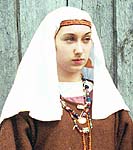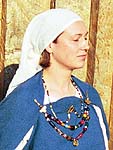 |
||||
|
Lesson #3: Page 6
A cloak or shawl could easily be drawn up over the head, to form a hood, and rectangular scarves, sometimes fringed are known from the North German and Danish bogs. Caps or hairnets of a technique known as sprang are known from archaeological sources (and are perhaps shown in some continental pictorial sources), often covering plaits or braids of hair. Pictorial and archaeological evidence also suggest the use of veils, usually of linen or fine wool. Some sources suggest they were draped loosely over unbound hair, but his may not have been their normal mode of wear. A veil is prone to slip, or be blown by the wind, so if a veil was to be worn it would either have a band over it to secure it, or a fixed base, such as a braid of hair and/or a cap, could be used to pin it to. Textile evidence from graves suggests that these veils could be pinned with a small brooch in the middle of the chest, or perhaps tucked inside the gown. Simple headscarves of fine linen or wool could be fixed in a variety of ways, either on their own or under a veil. These headscarves would probably be simple squares, rectangles or trianges of cloth worn pinned and tied in various ways. A simple headscarf has formed a part of folk or peasant dress in many parts of Europe and the rest of the world for many centuries. A few wealthy Kentish women were buried with gold brocaded fillets (perhaps known by the Latin word vitta, or the Old English words nostle, snod and þwæle), a fashion imported from the Frankish Kingdom. Possibly women in humbler circumstances wore fillets made entirely of textile which has since rotted away. The linguistic evidence suggests a wider range of headgear than archaeology and sculpture. The word hæt (hat) was in use as were cuffie (a loose fitting hood, veil or scarf) and scyfel (some kind of cap or hat). The binde, a fillet, may have been worn by married women. Click on image for larger version in new window Page
1 | Page 2 | Page
3 | Page 4 | Page
5 | Page 6 | Page 7 | Page
8
|
||||
| Costume
Classroom is a division of The
Costume Gallery, copyright 1997-2002.
Having problems with this webpage contact: questions@costumeclassgallery.com |


